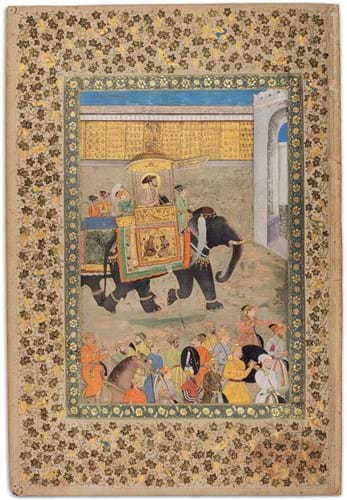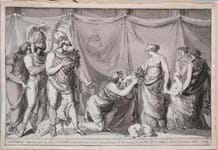
A rare 17th century Indian gouache showing the Mughal Emperor Shah Jahan and his entourage entering the city of Burhanpur sold in Paris at auction for a multi-estimate hammer price of €540,000 (£461,540).
The miniature offered by Millon (25% buyer’s premium) on December 2, one of only a few signed by the artist Abid, is dated to the third year of Shah Jahan’s reign (1630-31). It is thought to be one of the illustrations prepared for the Padshanameh, the official chronicle of Shah Jahan’s reign. The work is known today as the Windsor Padshanameh because it was sent in 1799 by the Nawab of Awadh to George III and is today in the royal collection.
The gouache, which is surrounded by an elaborate border decorated in blue and gilt, is mounted on an album leaf measuring 19 x 12½in (48.5 x 32cm) and decorated with grape vines and birds to the margins.
To the reverse is a calligraphic panel with a poetic quatrain that is also signed, in this case by Mir Emad al Hassani, one of the best-known Persian calligraphers of the 17th century.
Shah Jahan ascended to the throne of the Mughal empire in 1628. His reign was marked by a succession of military conquests, including the Deccan as a result of which he spent a good deal of time in Burhanpur which became his capital from 1630-32. It was also where his wife Mumtaz Mahal died in childbirth (Shah Jahan brought her body back to Agra where he created the Taj Mahal to serve as her tomb).
Abid’s painting shows the emperor seated on an elephant about to enter the city through a gateway. The artist was renowned for the detailed characterisation of his figures so it is possible to identify several of the people shown in the painting. Shah Jahan’s three eldest sons are shown as is Asaf Khan, Mumtaz Mahal’s father, who was prime minister, on horseback while Shaykh Nazi is distinguished by a distinctive headdress and the black and white sleeves of his robe.
The fact that the painting is dated is also significant. Only a handful of signed and dated paintings by Abid for the Padshanameh have been identified. One of them, showing the Shah Jahan enthroned with Mahabat Kahn, is dated 1629-30. Another, the death of Khan Jahan Lodi, is still extant in the Windsor Padshahnameh and is dated 1633. The example offered at Millon is between these two in date.
Sign of the time
The Islamic works of art specialist for the Millon auction, Anne-Sophie Joncoux Pilorget, reckons that it is the only signed miniature from the Padshahnameh by this artist to come on the market.
Stylistic similarities, particularly in the margin decoration of both the miniature and the calligraphic panel plus the page size, allow the entire page to be attributed to an album now preserved in St Petersburg. This was compiled between 1735-59 by Mahdi Kahn Astarbadi, the official chronicler of Nader Shah. The St Petersburg album is also notable for containing a major ensemble of Mir Emad’s calligraphy.
The page sold at Millon had a provenance to Antoine Kitabegi Khan (1843-1902). He was born in Constantinople, moved to Tehran in 1879 and went on to become general director of Persian customs, a position of importance in the Qajar Empire. The work had passed down by descent through his family.
As well as these features which made the work rare and desirable, Joncoux Pilorget singled out the fine condition of the Abid work, the details and the finesse of the painting which impressed even people who were not specialists in this field.
Offered with an estimate of €40,000-60,000, the work attracted as many as 20 international bidders on the day with 10 phone lines contesting bidders in the room. The buyer was the Rietberg Museum in Zurich.
£1 = €1.17














